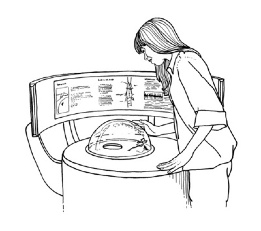| Franklin Institute and the Philadelphia Art Museum have the great virtue of displaying the old along with the new. I wish we could do so in the Exploratorium but we do not have access to the older material. Perhaps more sharing would be possible in this regard, for it can be extremely nice in all museums to show the continuity of history as well as the continuity of concepts. Many, many museums, from our very beginning, have been extraordinarily helpful to the Exploratorium. When I first started, I distributed our initial proposal widely. I sent one to Charles Blitzer at the Smithsonian, who I had met at the Burlington conference. An assistant of his, Diana Hamilton, got interested in it and wrote me that she thought it was most promising. So we met and she became our "agent" in Washington, with a modest retainer. She discovered for us the exhibit at the Corcoran Annex called Cybernetic Serendipity, which had been put together by the Institute for Contemporary Arts in London. She very wisely thought it would be a good beginning for our Exploratorium. So we talked with Renato Danise at the Corcoran Annex and he persuaded ICA in London to let us have it. He also looked into commercial transportation and found that it was much too expensive for us. So the Corcoran staff loaded Cybernetic Serendipity into a rental truck, drove it to San Francisco,and even helped us set it up. It was indeed a most important beginning for our place for it really set the stage for the kind of work we wanted to do because it combined perception, art, technology and science in a wonderful way. We still have some of its exhibit pieces that we purchased when the exhibit was disbursed 18 months later. (We originally had permission to show it for only six weeks.) The idea of using sketches of our exhibits in our exhibit catalog/textbooks came from an effort of the Toronto Museum. The National Gallery of Arts has boxes of printed sheets which explain all the exhibits in each room. We are contemplating something similar by having a series of laminated sheets in several areas of the Exploratorium together with a pay copying machine. |  | ||
| There are innumerable aspects of other museums that have influenced the Exploratorium. The art museum in Copenhagen has the wildest disarray of plaster casts stored, partially on display and partially helter-skelter in the basement of the museum that is open to the public. It is wonderful to see the bowels of a museum and to realize that a museum can be partly a hock shop and partly a Gumps window. There is a small house in the museum near Burlington, Vermont that contains nothing but decoy ducks. There is no text, no book or no film that could so effectively communicate the spirit, the sense of craftsmanship or the variety of ingenuity that has gone into the creation of decoy ducks as does that little section of a museum. It taught me a great lesson more effectively than any of the places that I have seen. It is there that I first appreciated how museums can enable people to find the essence of things through an enchanting multiplicity of examples. The San Francisco Steinhart Aquarium taught me another lesson. The fish there are captivating in part because they are always in motion. Science centers, on the other hand, tend to have static exhibits that are set in motion by the visitors. In the Exploratorium, a sizable fraction of the exhibits are continually in motion unless they are stopped or put under manual control by some action of the visitor. | |||